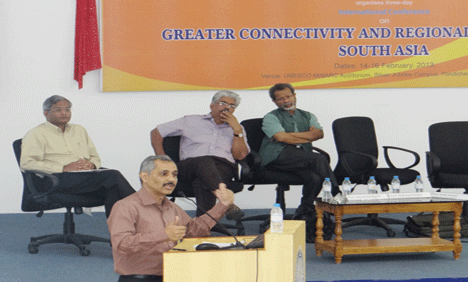Greater connectivity for regional prosperity

The South Asian region, although connected through almost all means of transportation (railways, sea, road and air) has very low intra-region trade. Currently regional trade in South Asia is about $10.4 billion — just five per cent of the area’s total trade.
Compare this to the over $40 billion (twenty per cent of trade) that economists estimate would be generated by normalising relations between the different neighbouring states (particularly India and Pakistan) and by extending the existing transport network.
These issues were the subject of deliberation at a conference on “Greater Connectivity and Regional Integration in South Asia”, held at the University of Pondicherry, India (Feb 14-16, 2013). Scholars from different South Asian countries attended the event, which was jointly organised by the UNESCO Madanjeet Singh Institute of South Asia Regional Co-operation and Public Diplomacy Division of Indian External Affairs Ministry.
The late Madanjeet Singh was born in Lahore in 1924 and migrated to India after partition. However, he always dreamt of a peaceful South Asia without barriers and hurdles. Towards this end, he established the South Asian Foundation (SAF) that he funded generously.
Now chaired by Mani Shankar Aiyar, the well-known former diplomat and Member of Parliament, SAF includes chapters from all SAARC countries and continues working to promote goodwill between all countries of the region.
To further bring people of South Asia closer, SAF offers scholarships for higher education, enabling students of SAARC countries to study at the University of Pondicherry as well. They include Pakistani student Ali Hasan Raza from Pattoki, in district Kasur, whom I met during the conference. He is doing his Masters in South Asian Studies and is very happy there. He hoped that other Pakistani students would also be able to benefit from this opportunity to study in such fully sponsored programmes.
One night at the conference, students from many countries highlighted their own cultures. I was happy to see Hasan Raza holding the flag of Pakistan. He told me later that Vice Chancellor of the Pondicherry, Prof. Chandra Krishnamurthy had noticed his dress shoes. She suggested that he wear Peshawari chappals, which would be more Pakistani than closed shoes.
As discussed at the conference, the Twelfth SAARC summit held in Islamabad in 2004 had emphasised the need to improve regional road networks. However, the goal remains elusive, largely due to constant stand-offs between two major states of the region, India and Pakistan. It is bilateral tensions between these two countries that are the major impediment to progress in the region, agreed conference participants.
As participants discussed, conflicts exist in other parts of the world too. However, progress can be made in trade, commerce and free movement of people if political conflicts are set aside. South Asia has great potential for progress and prosperity, given its natural connections, ranging from shared rivers to heritage and culture.
Conference discussions highlighted the need for India and Pakistan to end their animosity and focus on regional trade and commerce. The greater connectivity will benefit Pakistan more, given that it is a natural trade corridor between South Asia and Central and Western Asia. If such routes are restored, Pakistan may earn billions of dollars in royalty and taxes, easing financial constrains and reducing poverty.
Allowing trade routes would save precious resources and divert funds for socio-economic development, agreed participants. For example, currently a container takes 35 days to reach from Delhi to Dhaka via a third country (usually in the Middle East) whereas direct connection can reduce this time to just five days. Similarly the distance by sea between Islamabad and Dhaka is 7,612 km, which can be reduced to just 2,300 km over land across India. There are many other options to explore further.
Tourism, especially related to religious places, between India and Pakistan also has great potential to bring people of both countries closer. Allowing medical tourism and cultural exchanges would also enable greater connections between people of the region.
Divided families of Pakistan and India are the worst affected by the constant stand off. Generations have died without seeing their loved ones for decades.
It is time to move forward and seriously work towards the prosperity of the region. This will also reduce financial dependence on Western countries and lending institutions. This century is the century of Asia. Pakistan must get its due share by reducing barriers and bringing maximum benefits to its citizens.
On a personal note, as on my previous visits, I found common Indians very caring towards Pakistanis, yearning for India-Pakistan relations to be normalised, enabling people to visit each other’s countries and exchange goodwill.
Our host, Prof. Mohnan Pillai, Director of UMISARC left no stoned unturned to facilitate the delegates, especially me, a Pakistani. In fact, People extended so much affection, love and care that during my week’s stay in India I never felt as if I was away from home.
caption
“Greater Connectivity and Regional Integration in South Asia”: Scholars and students at the end of the conference
caption
The writer presenting his paper in the conference
caption
Diversity at Pondicherry University: students from different countries include Pakistani student Hassan Ali Raza (standing, centre, in purple kurta)
The writer heads the Social Sciences Department at Shaheed Zulfikar Ali Bhutto Institute of Science and Technology, Karachi; he presented a research paper at the conference in Pondicherry. Email: riaz.shaikh@szabist.edu.pk
Source: thenews













 Read more about "Pakistan"...
Read more about "Pakistan"... 